Allure-pytest功能特性介绍
前言
Allure框架是一个灵活的轻量级多语言测试报告工具,它不仅以web的方式展示了简介的测试结果,而且允许参与开发过程的每个人从日常执行的测试中最大限度的提取有用信息
从dev/qa的角度来看,Allure报告简化了常见缺陷的统计:失败的测试可以分为bug和被中断的测试,还可以配置日志、步骤、fixture、附件、计时、执行历史以及与TMS和BUG管理系统集成,所以,通过以上配置,所有负责的开发人员和测试人员可以尽可能的掌握测试信息。
从管理者的角度来看,Allure提供了一个清晰的“大图”,其中包括已覆盖的特性、缺陷聚集的位置、执行时间轴的外观以及许多其他方便的事情。allure的模块化和可扩展性保证了您总是能够对某些东西进行微调,使Allure更适合您,那么今天我们就来说说如何使报告更加详细的显示我们需要的信息,以及allure与jenkins的集成
生成报告
pytest框架编写的项目如何生成测试报告,这里将不再讲解,具体过程可以参考:pytest进阶之html测试报告
注意:python使用的allure插件为allure-pytest
测试代码
为了大家能够快速的认识allure的所有功能特性,附上完整的测试代码
"""
------------------------------------
@Time : 2019/8/28 19:50
@Auth : linux超
@File : conftest.py
@IDE : PyCharm
@Motto: Real warriors,dare to face the bleak warning,dare to face the incisive error!
@QQ : 28174043@qq.com
@GROUP: 878565760
------------------------------------
"""
import pytest
import allure @pytest.mark.hookwrapper
def pytest_runtest_makereport(item):
outcome = yield
report = outcome.get_result()
report.nodeid = report.nodeid.encode("utf-8").decode("unicode_escape") # 解决乱码 @allure.step("打开浏览器")
def fixture_step():
pass @pytest.fixture
def init_url():
fixture_step()
yield True
conftest.py
"""
------------------------------------
@Time : 2019/9/4 21:05
@Auth : linux超
@File : test_allure_feature.py
@IDE : PyCharm
@Motto: Real warriors,dare to face the bleak warning,dare to face the incisive error!
@QQ : 28174043@qq.com
@GROUP: 878565760
------------------------------------
"""
import pytest
import allure
import os def login(username=None, password=None):
"""模拟登录"""
user = "linux超"
pwd = ""
if user == username and pwd == password:
return {"code": 1001, "msg": "登录成功", "data": None}
elif "" == password or password is None and username:
return {"code": 1002, "msg": "密码不能为空", "data": None}
elif "" == username or username is None and password:
return {"code": 1003, "msg": "用户名不能为空", "data": None}
else:
return {"code": 1004, "msg": "用户名或密码错误", "data": None} @allure.step("输入用户名")
def input_username(user):
print("输入用户名")
return user @allure.step("输入密码")
def input_password(pwd):
print("输入密码")
return pwd login_success_data = [
# 测试数据
{
"case": "用户名正确, 密码正确",
"user": "linux超",
"pwd": "",
"expected": {"code": 1001, "msg": "登录成功", "data": None}
}
] login_fail_data = [
{
"case": "用户名正确, 密码为空",
"user": "linux超",
"pwd": "",
"expected": {"code": 1002, "msg": "密码不能为空", "data": None}
},
{
"case": "用户名为空, 密码正确",
"user": "",
"pwd": "linux超哥",
"expected": {"code": 1003, "msg": "用户名不能为空", "data": None}
},
{
"case": "用户名错误, 密码错误",
"user": "linux",
"pwd": "linux",
"expected": {"code": 1004, "msg": "用户名或密码错误", "data": None}
}
] username_none = [
{
"case": "缺省用户名参数",
"pwd": "",
"expected": {"code": 1003, "msg": "用户名不能为空", "data": None}
}
]
password_none = [
{
"case": "缺省密码参数",
"user": "linux超",
"expected": {"code": 1002, "msg": "密码不能为空", "data": None}
}
]
# 改变输出结果
ids_login_success_data = [
"测试{}用户名:{}密码{}期望值{}".
format(data["case"], data["user"], data["pwd"], data["expected"]) for data in login_success_data
]
ids_login_fail_data = [
"测试{}用户名:{}密码{}期望值{}".
format(data["case"], data["user"], data["pwd"], data["expected"]) for data in login_fail_data
]
ids_username_none = [
"测试{}密码{}期望值{}".
format(data["case"], data["pwd"], data["expected"]) for data in username_none
]
ids_password_none = [
"测试{}用户名:{}期望值{}".
format(data["case"], data["user"], data["expected"]) for data in password_none
] @allure.feature("登录模块")
class TestLogin(object): @allure.severity(allure.severity_level.BLOCKER)
@allure.story("测试登录成功")
@allure.title("登录成功场景-{data}")
@pytest.mark.parametrize("data", login_success_data, ids=ids_login_success_data)
def test_login_success(self, data):
"""测试登录成功"""
user = input_username(data["user"])
pwd = input_password(data["pwd"])
result = login(user, pwd)
assert result == data["expected"] @allure.severity(allure.severity_level.CRITICAL)
@allure.story("测试登录失败")
@pytest.mark.parametrize("data", login_fail_data, ids=ids_login_fail_data)
def test_login_fail(self, data):
"""测试用户名或密码错误"""
user = input_username(data["user"])
pwd = input_password(data["pwd"])
result = login(user, pwd)
assert result == data["expected"] @allure.severity(allure.severity_level.MINOR)
@allure.story("测试用户名参数缺失")
@pytest.mark.parametrize("data", username_none, ids=ids_username_none)
def test_username_none(self, data):
"""测试缺省用户名"""
pwd = input_password(data["pwd"])
result = login(password=pwd)
assert result == data["expected"] @allure.severity(allure.severity_level.MINOR)
@allure.story("测试密码参数缺失")
@pytest.mark.parametrize("data", password_none, ids=ids_password_none)
def test_password_none(self, data):
"""测试缺省密码"""
user = input_username(data["user"])
result = login(username=user)
assert result == data["expected"] @allure.severity(allure.severity_level.MINOR)
@allure.story("测试初始化地址")
@allure.testcase("https://www.cnblogs.com/linuxchao/", "测试用例地址")
def test_init_url(self, init_url):
flag = init_url
assert flag is True @allure.severity(allure.severity_level.NORMAL)
@allure.story("测试失败用例与用例中添加附件")
@allure.link("https://www.cnblogs.com/linuxchao/", name="bug链接")
@allure.description("这是一个一直执行失败的测试用例")
def test_failed(self):
"""你也可以在这里添加用例的描述信息,但是会被allure.description覆盖"""
try:
assert False
except AssertionError as e:
with open("attach.png", "rb") as f:
context = f.read()
allure.attach(context, "错误图片", attachment_type=allure.attachment_type.PNG)
raise e @allure.severity(allure.severity_level.TRIVIAL)
@allure.story("测试broken用例")
@allure.issue("https://www.cnblogs.com/linuxchao/", "错误链接")
def test_broken(self):
"""broken"""
with open("broken.json", "r", encoding='utf8') as f:
f.read() @allure.severity(allure.severity_level.TRIVIAL)
@allure.story("测试无条件跳过测试用例")
@pytest.mark.skip(reason="无条件跳过")
def test_skip(self):
"""skip"""
pass if __name__ == '__main__':
pytest.main(["-vsq",
"--alluredir", "./allure-results", ])
os.system(r"allure generate --clean ./allure-results -o ./allure-report")
test_allure_feature.py
"""
------------------------------------
@Time : 2019/8/28 19:45
@Auth : linux超
@File : test_allure_fixture.py
@IDE : PyCharm
@Motto: Real warriors,dare to face the bleak warning,dare to face the incisive error!
@QQ : 28174043@qq.com
@GROUP: 878565760
------------------------------------
"""
import pytest
import os
import allure def function_scope_step():
print("function_scope_step") def class_scope_step():
print("class_scope_step") def module_scope_step():
print("module_scope_step") def session_scope_step():
print("session_scope_step") def step_inside_test_body():
print("step_inside_test_body") @pytest.fixture(params=[True, False], ids=['param_true', 'param_false'])
def function_scope_fixture_with_finalizer(request):
if request.param:
print('True')
else:
print('False') def function_scope_finalizer():
function_scope_step() request.addfinalizer(function_scope_finalizer) @pytest.fixture(scope='class')
def class_scope_fixture_with_finalizer(request):
def class_finalizer_fixture():
class_scope_step() request.addfinalizer(class_finalizer_fixture) @pytest.fixture(scope='module')
def module_scope_fixture_with_finalizer(request):
def module_finalizer_fixture():
module_scope_step() request.addfinalizer(module_finalizer_fixture) @pytest.fixture(scope='session')
def session_scope_fixture_with_finalizer(request):
def session_finalizer_fixture():
session_scope_step() request.addfinalizer(session_finalizer_fixture) @allure.severity(allure.severity_level.BLOCKER)
@allure.feature("fixture场景")
class TestClass(object): def test_with_scoped_finalizers(self,
function_scope_fixture_with_finalizer,
class_scope_fixture_with_finalizer,
module_scope_fixture_with_finalizer,
session_scope_fixture_with_finalizer):
step_inside_test_body() if __name__ == '__main__':
pytest.main(["-vsq",
"--alluredir", "./allure-results", ])
os.system(r"allure generate --clean ./allure-results -o ./allure-report")
test_allure_fixture.py
[
{
"name": "Ignored tests",
"matchedStatuses": ["skipped"]
},
{
"name": "Infrastructure problems",
"matchedStatuses": ["broken", "failed"],
"messageRegex": ".*bye-bye.*"
},
{
"name": "Outdated tests",
"matchedStatuses": ["broken"],
"traceRegex": ".*FileNotFoundException.*"
},
{
"name": "Product defects",
"matchedStatuses": ["failed"]
},
{
"name": "Test defects",
"matchedStatuses": ["broken"]
}
]
categories.json
Browser=Chrome
Browser.Version=63.0
Stand=Production
ApiUrl=127.0.0.1/login
python.Version=3.6
environment.properties
"""
------------------------------------
@Time : 2019/9/3 14:21
@Auth : linux超
@File : run.py
@IDE : PyCharm
@Motto: Real warriors,dare to face the bleak warning,dare to face the incisive error!
@QQ : 28174043@qq.com
@GROUP: 878565760
------------------------------------
"""
import pytest
import os if __name__ == '__main__':
pytest.main(["-sq",
"--alluredir", "./allure-results"])
os.system(r"allure generate --clean allure-results -o allure-report")
run.py
目录结构
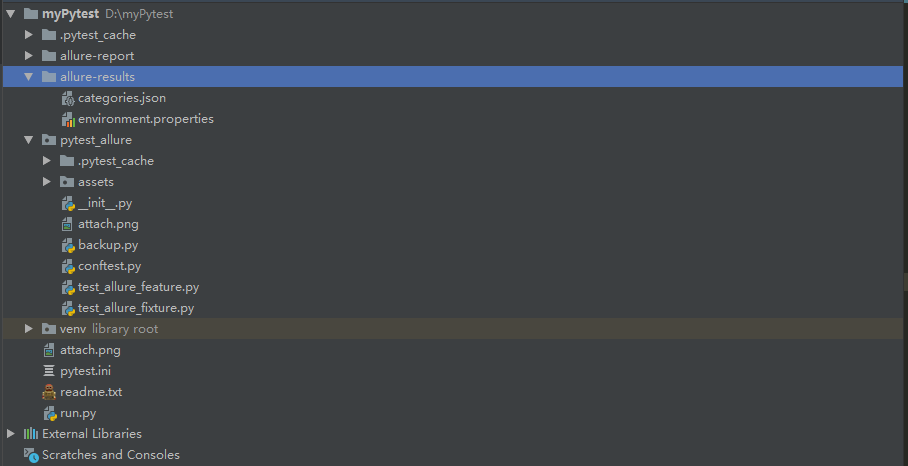
Allure特性
Environment
在Allure报告中添加环境信息,通过创建environment.properties或者environment.xml文件,并把文件存放到allure-results(这个目录是生成最后的html报告之前,生成依赖文件的目录)目录下
environment.properties
Browser=Chrome
Browser.Version=63.0
Stand=Production
ApiUrl=127.0.0.1/login
python.Version=3.6
或者
environment.xml
<environment>
<parameter>
<key>Browser</key>
<value>Chrome</value>
</parameter>
<parameter>
<key>Browser.Version</key>
<value>63.0</value>
</parameter>
<parameter>
<key>Stand</key>
<value>Production</value>
</parameter>
<parameter>
<key>ApiUrl</key>
<value>127.0.0.1/login</value>
</parameter>
<parameter>
<key>python.Version</key>
<value>3.6</value>
</parameter>
</environment>
执行run.py查看报告
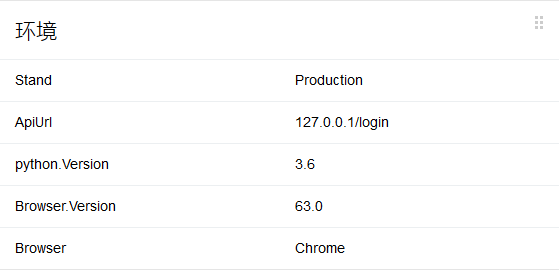
Categories
测试报告默认统计两种类型的测试用例结果,失败的用例和故障测试用例,我们可以自定义添加用例的统计类型,同样需要在allure-results目录下新建categories.json文件
[
{
"name": "Ignored tests",
"matchedStatuses": ["skipped"]
},
{
"name": "Infrastructure problems",
"matchedStatuses": ["broken", "failed"],
"messageRegex": ".*bye-bye.*"
},
{
"name": "Outdated tests",
"matchedStatuses": ["broken"],
"traceRegex": ".*FileNotFoundException.*"
},
{
"name": "Product defects",
"matchedStatuses": ["failed"]
},
{
"name": "Test defects",
"matchedStatuses": ["broken"]
}
]
执行run.py查看报告

Fixtures and Finalizers
Fixtures和Finalizers是pytest在测试开始和测试结束调用的方法,allure会自动跟踪每一个fixture的调用,并且详细显示会调用哪些fixture和参数,而且会保留正确的调用顺数
测试代码
test_allure_html.py
def function_scope_step():
print("function_scope_step") def class_scope_step():
print("class_scope_step") def module_scope_step():
print("module_scope_step") def session_scope_step():
print("session_scope_step") def step_inside_test_body():
print("step_inside_test_body") @pytest.fixture(params=[True, False], ids=['param_true', 'param_false'])
def function_scope_fixture_with_finalizer(request):
if request.param:
print('True')
else:
print('False') def function_scope_finalizer():
function_scope_step() request.addfinalizer(function_scope_finalizer) @pytest.fixture(scope='class')
def class_scope_fixture_with_finalizer(request):
def class_finalizer_fixture():
class_scope_step() request.addfinalizer(class_finalizer_fixture) @pytest.fixture(scope='module')
def module_scope_fixture_with_finalizer(request):
def module_finalizer_fixture():
module_scope_step() request.addfinalizer(module_finalizer_fixture) @pytest.fixture(scope='session')
def session_scope_fixture_with_finalizer(request):
def session_finalizer_fixture():
session_scope_step() request.addfinalizer(session_finalizer_fixture) class TestClass(object): def test_with_scoped_finalizers(self,
function_scope_fixture_with_finalizer,
class_scope_fixture_with_finalizer,
module_scope_fixture_with_finalizer,
session_scope_fixture_with_finalizer):
step_inside_test_body()
执行run.py查看报告
@allure.step
pytest支持使用@allure.step修饰某些测试用例中需要的函数,使测试用例在allure报告中能够更加详细的显示测试过程
测试代码
test_allure_feature.py文件中修改如下代码
@allure.step("输入用户名")
def input_username():
print("输入用户名")
@allure.step("输入密码")
def input_password():
print("输入密码")
执行run.py查看报告
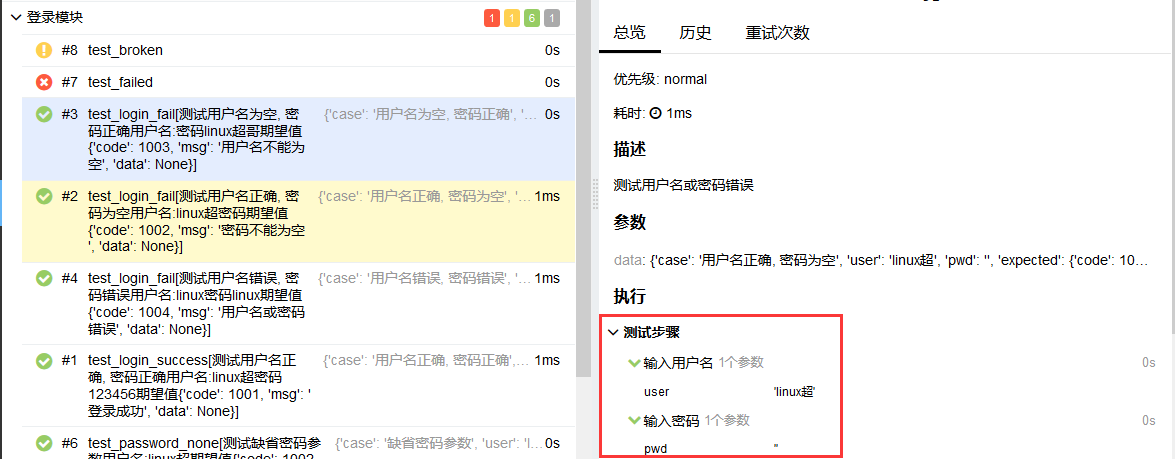
conftest.py
@allure.step修饰的测试步骤还支持在conftest.py文件中定义,作为fixture的步骤,现在我们在项目目录下新建conftest.py文件,写入如下代码
conftest.py
@allure.step("打开浏览器")
def fixture_step():
pass
@pytest.fixture
def init_url():
fixture_step()
yield True
test_allure_feature.py文件中添加如下用例
def test_init_url(self, init_url):
flag = init_url
assert flag == True
执行run.py查看报告

allure.attach
使用allure.attach可以给报告中添加文件,图片,log,html代码等等。 我们修改test_allure_feature.py中如下用例, 并在用例所在目录添加attach.png图片
def test_failed(self):
"""failed"""
try:
assert False
except AssertionError as e:
with open("attach.png", "rb") as f:
context = f.read()
allure.attach(context, "错误图片", attachment_type=allure.attachment_type.PNG)
raise e
执行run.py查看报告
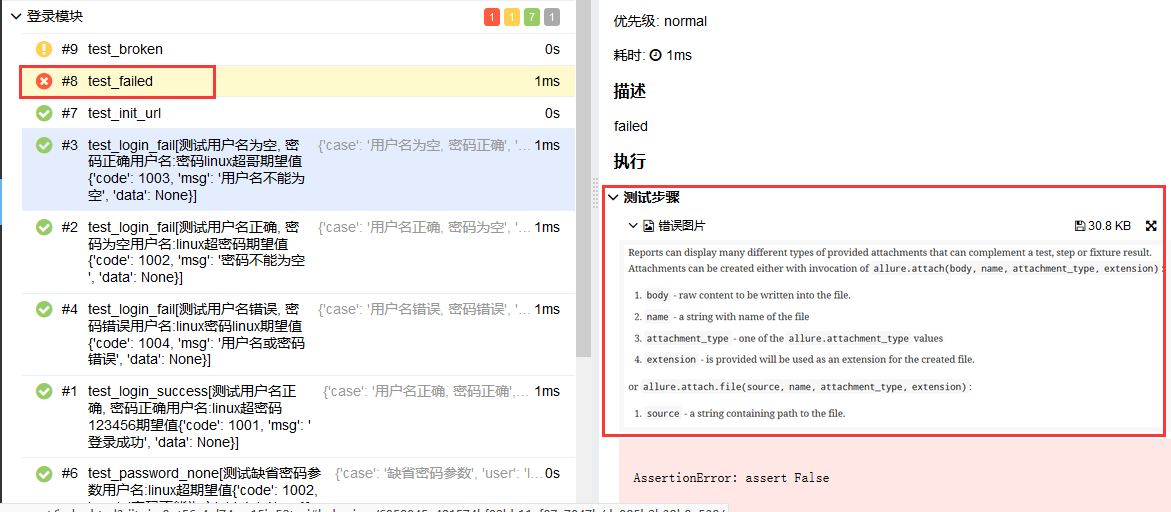
@allure.description
如果你想在报告中展示测试用例的描述信息,那么你可以使用@allure.description(string)或者@allure.description_html(html代码)修饰你的测试用例,test_allure_feature.py文件修改如下代码
@allure.description("这是一个一直执行失败的测试用例")
def test_failed(self):
"""你也可以在这里添加用例的描述信息,但是会被allure.description覆盖"""
try:
assert False
except AssertionError as e:
with open("attach.png", "rb") as f:
context = f.read()
allure.attach(context, "错误图片", attachment_type=allure.attachment_type.PNG)
raise e
执行run.py查看报告
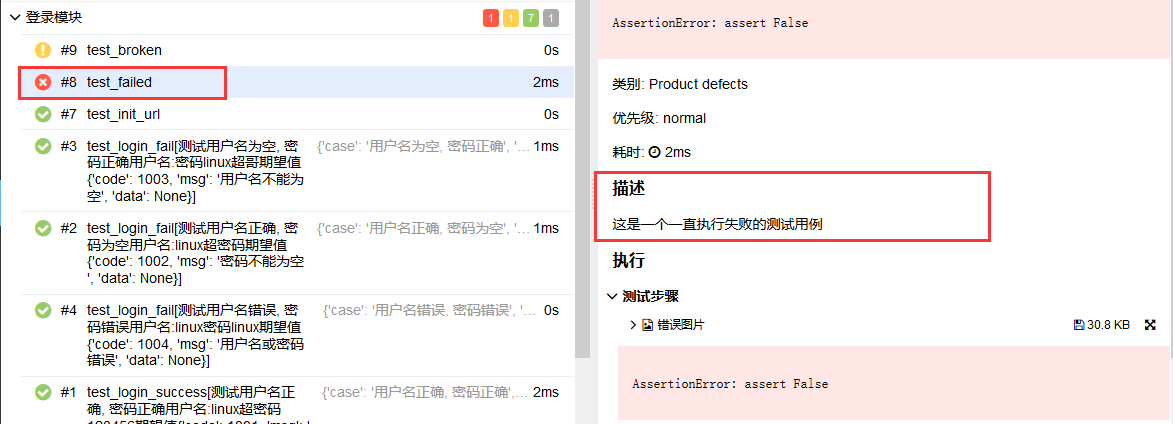
@allure.title
使用allure.title(title)可以重命名测试用例在allure报告中的名称,test_allure_feature.py文件修改如下代码
@allure.title("登录成功场景-{data}")
@pytest.mark.parametrize("data", login_success_data, ids=ids_login_success_data)
def test_login_success(self, data):
"""测试登录成功"""
user = input_username(data["user"])
pwd = input_password(data["pwd"])
result = login(user, pwd)
assert result == data["expected"]

@allure.link
@allure.testcase
@allure.issue
这三种特性都可以给测试用例添加一个链接,test_allure_feature.py文件修改如下代码
@allure.testcase("https://www.cnblogs.com/linuxchao/", "测试用例地址")
def test_init_url(self, init_url):
flag = init_url
assert flag == True
@allure.link("https://www.cnblogs.com/linuxchao/", name="bug链接")
@allure.description("这是一个一直执行失败的测试用例")
def test_failed(self):
"""你也可以在这里添加用例的描述信息,但是会被allure.description覆盖"""
try:
assert False
except AssertionError as e:
with open("attach.png", "rb") as f:
context = f.read()
allure.attach(context, "错误图片", attachment_type=allure.attachment_type.PNG)
raise e
@allure.issue("https://www.cnblogs.com/linuxchao/", "错误链接")
def test_broken(self):
"""broken"""
with open("broken.json", "r", encoding='utf8') as f:
f.read()
执行run.py查看报告



@allure.feature
@allure.story
feature和story被称为行为驱动标记,因为使用这个两个标记,通过报告可以更加清楚的掌握每个测试用例的功能和每个测试用例的测试场景
在test_allure_feature.py文件中的测试类使用@allure.feature修饰, 测试方法使用@allure.story修饰
执行run.py查看报告
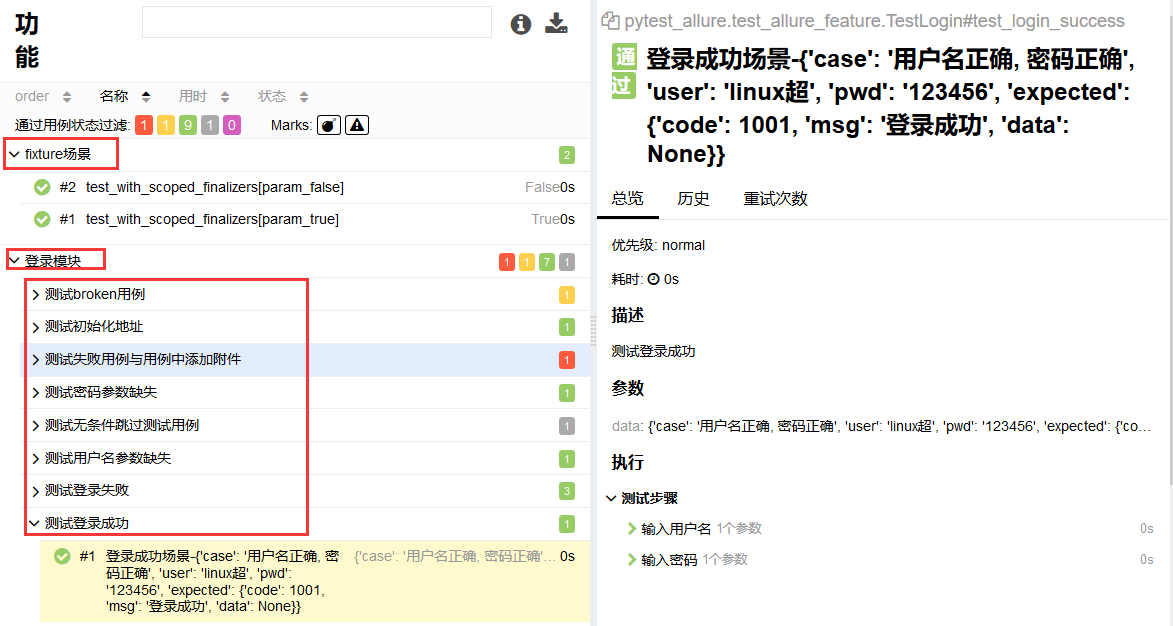
以上两种标记不仅仅能够在测试报告中显示,而且还可以使用命令执行指定的测试模块或者场景

@allure.severity
此标记用来标识测试用例或者测试类的级别,分为blocker,critical,normal,minor,trivial5个级别,下面们把测试用例按级别标记,并查看一下测试报告

总结
以上就是所有的allure-pytest插件在pytest中支持的大部分功能特性,也许整理的不是很详细,所以如果你想详细的了解具体的特性在报告中的效果,还需自己动手尝试一下,附上本文参考链接
https://docs.qameta.io/allure/
Allure-pytest功能特性介绍的更多相关文章
- Pytest框架介绍
Pytest框架介绍.安装 pytest是python测试框架,与python自带的unittest测试框架类似,但是比unittest框架使用起来更简洁,功能更强大 pytest特征 1:断言提示信 ...
- Allure+pytest 生成测试报告
简介: python 主流自动化测试报告插件有三个:HTMLTestRunner.BeautifulReport 和 Allure.HTMLTestRunner是一个比较古老的报告模板,界面也不是很好 ...
- try easy pytest 1tep介绍
『 tep is a testing tool to help you write pytest more easily. Try Easy Pytest! 』 tep前身 tep的前身是接口自动化测 ...
- pytest一:pytest 框架介绍
pytest 是 python 的一种单元测试框架,与python 自带的 unittest测试框架类似,但是比 unittest 框架使用起来更简洁,效率更高.根据pytest 的官方网站介绍,它具 ...
- Pytest安装介绍--使用(html报告)
Pytes是 一个单元测试框架,可以生成html报告. #卸载# pip uninstall pytest#安装# pip install -U pytest# 查看# pytest --versio ...
- pytest框架-介绍、Mark(打标签)、命令运行用例、用例执行顺序、
1.pytest介绍:基于unittest 之上的单元测试框架 1.1.自动发现测试模块和测试用例: unitest 需要添加用例,(泰斯特楼贷)加载器加载测试用例 pytest 只需要一条代码就可以 ...
- Pytest - 使用介绍
1. 概述 pytest是一个非常成熟的全功能的Python测试框架,主要特点有以下几点: 1.简单灵活,容易上手,文档丰富: 2.支持参数化,可以细粒度地控制要测试的测试用例: 3.能够支持简单的单 ...
- Pytest 学习(二十七)- Jenkins+Allure+Pytest的持续集成
一.配置 allure 环境变量 1.下载 allure是一个命令行工具,可以去 github 下载最新版:https://github.com/allure-framework/allure2/re ...
- 2012版辅助开发工具包(ADT)新功能特性介绍及安装使用
原文链接:http://android.eoe.cn/topic/android_sdk 2012年的Android辅助设备开发工具包(ADK)是Android开放设备协议(AOA)设备的最新参考实现 ...
随机推荐
- 有趣的RPC理解
RPC(Remote Procedure Call)—远程过程调用,它是一种通过网络从远程计算机程序上请求服务,而不需要了解底层网络技术的协议.RPC协议假定某些传输协议的存在,如TCP或UDP,为通 ...
- 解决 Android 中出现依赖多个版本支持库的问题
在 app 的 build.gradle 中引入依赖时发现如下错误: All com.android.support libraries must use the exact same version ...
- Kafka面试,看这篇文章就够了
原文链接:https://mp.weixin.qq.com/s/zxPz_aFEMrshApZQ727h4g** 引言 MQ(消息队列)是跨进程通信的方式之一,可理解为异步rpc,上游系统对调用结果的 ...
- 带你剖析WebGis的世界奥秘----点和线的世界
前言 昨天写了好久的博文我没保存,今天在来想继续写居然没了,气死人啊这种情况你们见到过没,所以今天重新写,我还是切换到了HTML格式的书写上.废话不多说了,我们现在就进入主题,上周我仔细研究了WebG ...
- 并发模型与IO模型梳理
并发模型 常见的并发模型一般包括3类,基于线程与锁的内存共享模型,actor模型和CSP模型,其中尤以线程与锁的共享内存模型最为常见.由于go语言的兴起,CSP模型也越来越受关注.基于锁的共享内存模型 ...
- 消息中间件——RabbitMQ(三)理解RabbitMQ核心概念和AMQP协议!
前言 本章学习,我们可以了解到以下知识点: 互联网大厂为什么选择RabbitMQ? RabbiMQ的高性能之道是如何做到的? 什么是AMQP高级协议? AMQP核心概念是什么? RabbitMQ整体架 ...
- 基于Spring Boot自建分布式基础应用
目前刚入职了一家公司,要求替换当前系统(单体应用)以满足每日十万单量和一定系统用户负载以及保证开发质量和效率.由我来设计一套基础架构和建设基础开发测试运维环境,github地址. 出于本公司开发现状及 ...
- Java - 手动解析不带引号的JSON字符串
目录 1 需求说明 2 解析代码 2.1 实现思路 2.2 详细代码 2.3 测试样例 1 需求说明 项目中遇到了一批不带引号的类JSON格式的字符串: {Name:Heal,Age:20,Tag:[ ...
- nginx单机1w并发优化
目录 ab工具 整体优化思路 具体的优化思路 编写脚本完成并发优化配置 性能统计工具 tips 总结 ab工具 ab -c 10000 -n 200000 http://localhost/index ...
- Linux系统@根目录下各目录作用归纳图
